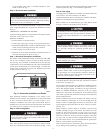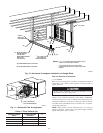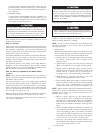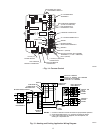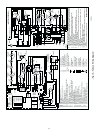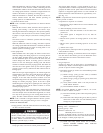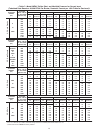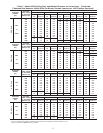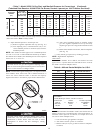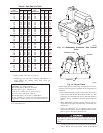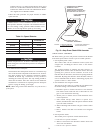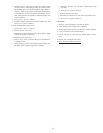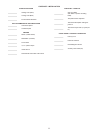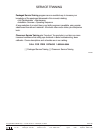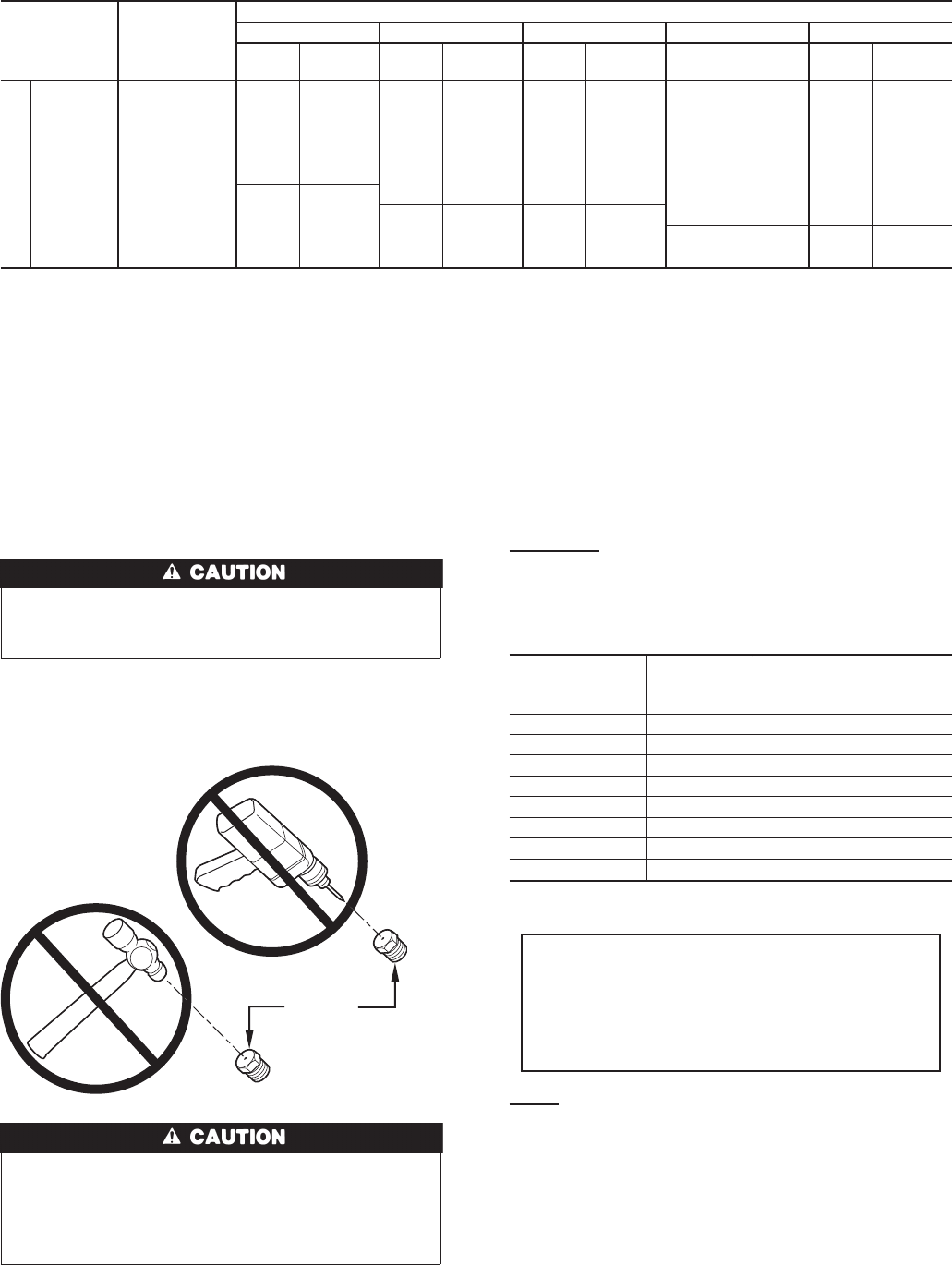
b. Adjust manifold pressure to obtain input rate.
(1.) Remove regulator adjustment seal cap. (See Fig. 18.)
(2.) Turn adjusting screw, counterclockwise (out) to de-
crease manifold pressure or clockwise (in) to increase
manifold pressure.
NOTE: This furnace has been approved for a manifold pressure
of 3.2-in. wc to 3.8-in. wc when installed at altitudes up to 2000 ft.
For altitudes above 2000 ft, the manifold pressure can be adjusted
from 2.0-in. wc to 3.8-in. wc.
DO NOT bottom out gas valve regulator adjusting screw.
This can result in unregulated manifold pressure and result in
excess overfire and heat exchanger failures.
NOTE: If orifice hole appears damaged or it is suspected to have
been redrilled, check orifice hole with a numbered drill bit of
correct size. Never redrill an orifice. A burr-free and squarely
aligned orifice hole is essential for proper flame characteristics.
(3.) After correct manifold pressure is obtained, replace
gas valve regulator adjustment screw cap and verify
adjusted gas input rate using method outlined in item
c.
(4.) Burner flame should be clear blue, almost transparent.
(See Fig. 19.)
c. Verify natural gas input rate by clocking gas meter.
NOTE: High-Altitude Adjustment
United States
At installation altitudes above 2000 ft, this furnace has been
approved for a 4 percent derate for each 1000 ft above sea level.
See Table 8 for derate multiplier factor.
EXAMPLE:
92,000 Btuh input furnace installed at 4300 ft.
Furnace Input
Rate at
Sea Level
X
Derate
Multiplier
Factor
=
Furnace Input Rate
at Installation
Altitude
92,000 0.82 75,440
Canada
At installation altitudes from 2000 to 4500 ft, this furnace must be
derated 10 percent by an authorized Gas Conversion Station. To
determine correct input rate for altitude, see example above and
use 0.90 as derate multiplier factor.
a. Turn off all other gas appliances and pilots.
b. Start furnace and let operate for 3 minutes.
c. Measure time (in sec) for gas meter test dial to complete 1
revolution.
→Table 7—Model 58ZAV Orifice Size† and Manifold Pressure for Correct Input (Continued)
(Tabulated Data Based on 23,000 BTUH Per Burner, Derated 4 percent per 1000 Ft Above Sea Level)*
ALTITUDE
RANGE
(FT)
AVG GAS
HEAT VALUE
AT ALTITUDE
(BTU/CU FT)
SPECIFIC GRAVITY OF NATURAL GAS
0.58 0.60 0.62 0.64 0.66
Orifice
No.
Manifold
Pressure
Orifice
No.
Manifold
Pressure
Orifice
No.
Manifold
Pressure
Orifice
No.
Manifold
Pressure
Orifice
No.
Manifold
Pressure
U.S.A. Only
575 43 3.0 43 3.1 43 3.2 43 3.3 43 3.4
600 43 2.7 43 2.8 43 2.9 43 3.0 43 3.1
9001 625 43 2.5 43 2.6 43 2.7 43 2.8 43 2.8
650 43 2.3 43 2.4 43 2.5 43 2.6 43 2.6
to 675 43 2.1 43 2.2 43 2.3 43 2.4 43 2.4
700 48 3.8 43 2.1 43 2.1 43 2.2 43 2.3
10,000 725 48 3.5 48 3.6 48 3.7 43 2.1 43 2.1
750 49 3.8 48 3.4 48 3.5 48 3.6 48 3.7
775 49 3.6 49 3.7 49 3.8 48 3.4 48 3.5
* For size 135-20 only, input is 22,500 Btuh per burner. Deduct 0.1-in. wc from manifold pressure shown in table. Change orifice size if manifold pressure falls below
3.2-in. wc on altitudes up to 2000 ft, otherwise change orifice size if manifold pressure falls below 2.0-in. wc.
† Orifice sizes shown in BOLD are factory installed.
DO NOT redrill orifices. Improper drilling (burrs, out-of-
round holes, etc.) can cause excessive burner noise and
misdirection of burner flames. This can result in flame
impingement of burners and heat exchangers, causing
failures..
A93059
BURNER
ORIFICE
Table 8—Altitude Derate Multiplier for U.S.A.
ALTITUDE
(FT)
%OF
DERATE
DERATE MULTIPLIER
FACTOR FOR U.S.A*
0—2000 0 1.00
2001—3000 8—12 0.90
3001—4000 12—16 0.86
4001—5000 16—20 0.82
5001—6000 20—24 0.78
6001—7000 24—28 0.74
7001—8000 28—32 0.70
8001—9000 32—36 0.66
9001—10,000 36—40 0.62
* Derate multiplier factor is based on midpoint altitude for altitude range.
18



